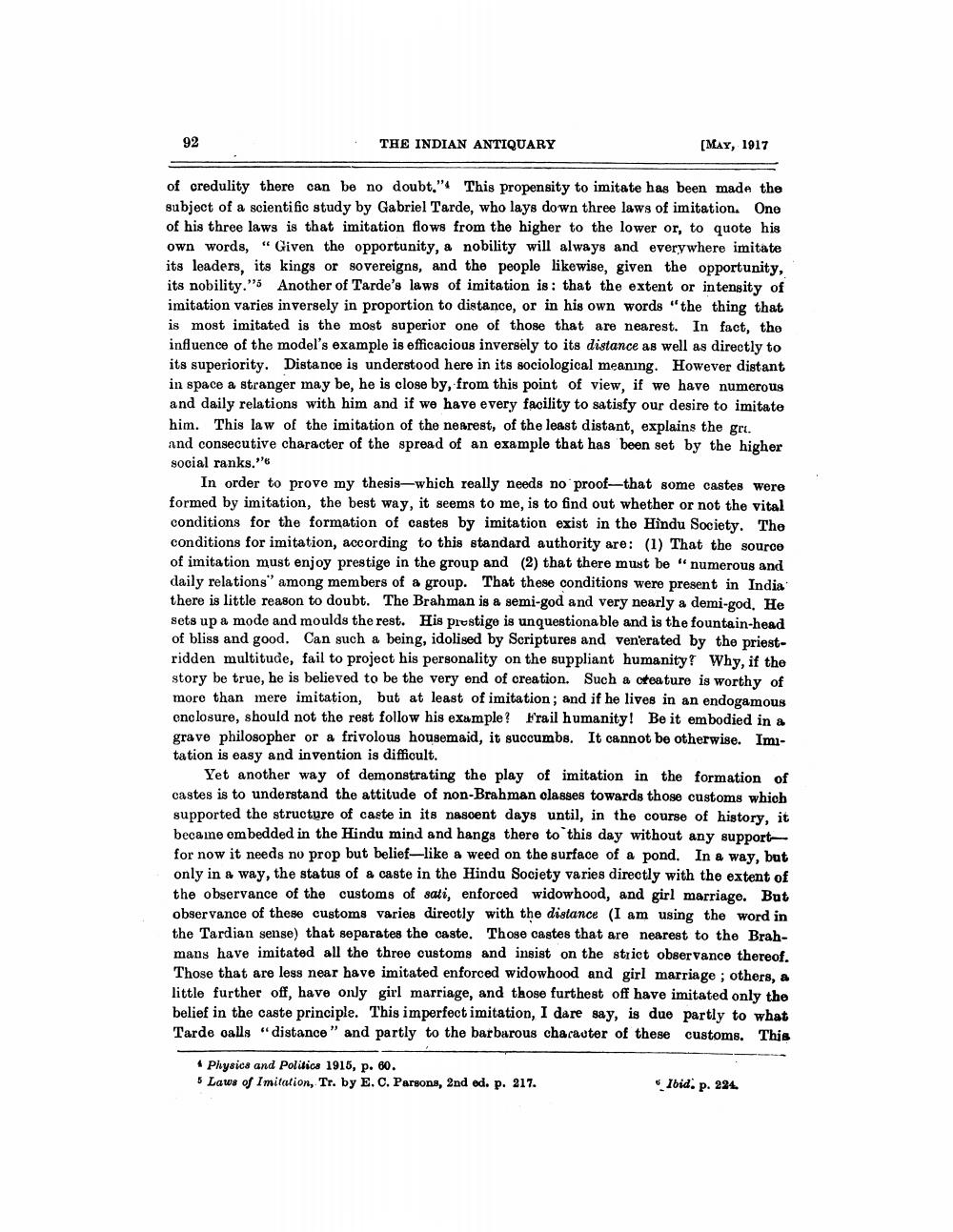________________
92
THE INDIAN ANTIQUARY
[MAY, 1917
of credulity there can be no doubt." This propensity to imitate has been made the subject of a scientific study by Gabriel Tarde, who lays down three laws of imitation. One of his three laws is that imitation flows from the higher to the lower or, to quote his own words, "Given the opportunity, a nobility will always and everywhere imitate its leaders, its kings or sovereigns, and the people likewise, given the opportunity, its nobility."5 Another of Tarde's laws of imitation is: that the extent or intensity of imitation varies inversely in proportion to distance, or in his own words "the thing that is most imitated is the most superior one of those that are nearest. In fact, the influence of the model's example is efficacious inversely to its distance as well as directly to its superiority. Distance is understood here in its sociological meaning. However distant in space a stranger may be, he is close by, from this point of view, if we have numerous and daily relations with him and if we have every facility to satisfy our desire to imitate him. This law of the imitation of the nearest, of the least distant, explains the gri. and consecutive character of the spread of an example that has been set by the higher social ranks."
In order to prove my thesis-which really needs no proof-that some castes were formed by imitation, the best way, it seems to me, is to find out whether or not the vital conditions for the formation of castes by imitation exist in the Hindu Society. The conditions for imitation, according to this standard authority are: (1) That the source of imitation must enjoy prestige in the group and (2) that there must be "numerous and daily relations" among members of a group. That these conditions were present in India there is little reason to doubt. The Brahman is a semi-god and very nearly a demi-god. He sets up a mode and moulds the rest. His prestige is unquestionable and is the fountain-head of bliss and good. Can such a being, idolised by Scriptures and venerated by the priestridden multitude, fail to project his personality on the suppliant humanity? Why, if the story be true, he is believed to be the very end of creation. Such a creature is worthy of more than mere imitation, but at least of imitation; and if he lives in an endogamous enclosure, should not the rest follow his example? Frail humanity! Be it embodied in a grave philosopher or a frivolous housemaid, it succumbs. It cannot be otherwise. Imitation is easy and invention is difficult.
Yet another way of demonstrating the play of imitation in the formation of castes is to understand the attitude of non-Brahman classes towards those customs which supported the structure of caste in its nascent days until, in the course of history, it became embedded in the Hindu mind and hangs there to this day without any supportfor now it needs no prop but belief-like a weed on the surface of a pond. In a way, but only in a way, the status of a caste in the Hindu Society varies directly with the extent of the observance of the customs of sati, enforced widowhood, and girl marriage. But observance of these customs varies directly with the distance (I am using the word in the Tardian sense) that separates the caste. Those castes that are nearest to the Brahmans have imitated all the three customs and insist on the strict observance thereof. Those that are less near have imitated enforced widowhood and girl marriage; others, a little further off, have only girl marriage, and those furthest off have imitated only the belief in the caste principle. This imperfect imitation, I dare say, is due partly to what Tarde calls "distance" and partly to the barbarous character of these customs. This
4 Physics and Politics 1915, p. 60.
5 Laws of Imitation, Tr. by E. C. Parsons, 2nd ed. p. 217.
Ibid. p. 224.




